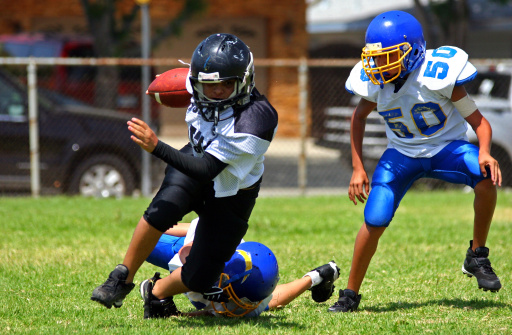
The recent football recruiting scandal that rocked West Point (Roeder, 2014) smacked of similar incidents involving both military and civilian athletic programs at schools across the country. And while the Academy sought refuge in the “harsh punishment” it levied against the cadets involved, it simultaneously pointed out that what transpired is deemed to be only a “minor infraction” by the National Collegiate Athletic Association (NCAA).
Exactly.
Feting underage high school youth with alcohol, women and a charter bus party constitutes an infraction against minors, at a time when the well-recognized plasticity of adolescent brains places them at risk for poor decision-making and the social, emotional and cognitive fallout that can ensue.
Moreover, that this event was given the green light by adults in charge, despite a disturbing decade-old tradition, points to the mixed messages that permeate the toxic world of youth and alcohol.
When high school and college worlds collide, kids often suffer the collateral damage. One such incident at a tony private college in New England prompted a 2003 study by SADD (Students Against Destructive Decisions) that revealed a trend of risk behavior by high school students on college campuses (SADD, 2003).
According to that research, almost four in ten teens (39.1 percent) who had stayed overnight on a college campus reported engaging in drinking, other drug use or sex during those visits. The study also indicated that these dangerous behaviors were far more prevalent among boys than among girls.
• Sex – More than one in four teens (28 percent) reported “having sex,” and an additional 4.2 percent reported engaging in other types of sexual activity.
• Drinking – One in four teens (25.5 percent) reported drinking alcohol.
• Drugs (other than alcohol) – More than one in five teens (21.5 percent) reported using other drugs.
• All risky behaviors – One in eight teens (12.4 percent) reported engaging in all of the dangerous behaviors: drinking, other drug use and sexual activity.
Among the respondents, boys were two to three times more likely than girls to report having sex (41.5 percent vs. 14.6 percent), drinking (36.3 percent vs. 14.8 percent) or using other drugs (29.7 percent vs. 11.6 percent).
Times have changed.
With almost a decade for colleges and universities to enhance safety (and legal) measures, mostly through student-host training, administrative/athletic oversight, and social contracts, progress was noted in a 2012 study by SADD and the Center for Adolescent Research and Education (CARE) conducted by ORC International (CARE, 2012). That report indicated that among the cohort of high school students staying overnight on a college campus as part of their school selection process – those colleges tend to know about – roughly one in six surveyed (16 percent) reported drinking alcohol during the visit. Teens also reported engaging in sex or other intimate sexual behavior (17 percent), using drugs other than alcohol (5 percent) or driving while impaired (2 percent).
Better but still not great.
For some teens, the college visit was the first time they engaged in some of these behaviors. For example, 51 percent of teens who reported drinking during the overnight visit said they had done so for the first time. Fifty-two percent of respondents who reported engaging in some type of sexual activity during their visit indicated that they participated in behaviors in which they had not previously engaged.
It is also interesting to note that data from the same study points to the fact that, in general, girls and young women have caught up to – and in some cases passed – their male peers in terms of engagement in risk behaviors (Wallace, 2013).
For example, among 16-year-olds, girls outpaced boys in reporting alcohol use (26 percent vs. 20 percent). By age 17, girls also pulled ahead of boys on other drug use (13 percent vs. 7 percent) and by age nineteen in each of the areas studied:
• Drinking (52 percent vs. 40 percent);
• Using other drugs (19 percent vs. 15 percent); and
• Driving under the influence (10 percent vs. 7 percent).
Perhaps not surprisingly, similar disparities exist for intimate sexual behavior and intercourse.
"These results speak to parents about the importance of communicating about risks and setting expectations for their teens in advance of new and potentially challenging experiences," said Penny Wells, SADD’s president and CEO. "The temptations are waiting for these young people when they visit schools of interest and also when they go off to the next phase of their lives at college. Parents should open a strong communication channel with their teens to guide them in the right direction."
Risks aside, college visits remain an important staple of the higher education selection process. But parents, teens and colleges must share responsibility for keeping young people safe during the sampling process. Some practical measures might include the following.
Parents
• Accompany your teens on college visits and find accommodations at an off-campus hotel.
• Discuss with your teens the choices they may have to make and role-play how they might best respond. Teens with parents who regularly engage them in open, honest dialogue about such important issues are much less likely to make poor choices.
• Explain your expectations. Parents who provide a strong level of guidance to their teens are more likely to have children who avoid destructive behaviors.
Teens
• Understand the risk behaviors you might encounter during a college visit.
• Explore possible dangerous "scenarios" with your parents and ask about their expectations for your behavior. Knowing what those expectations are will make it more likely you will to try to meet them.
• Decide ahead of time (i.e., "in the event of") what choices you feel comfortable with. This will make it easier to do the right thing when a moment of decision arrives.
Colleges
• Assess the current risk behaviors of your students and visitors to campus.
• Respond with clear, firm policies that protect students, visitors and hosts.
• Communicate and enforce campus rules. Students, underage guests and their parents need to know that your college is serious about keeping young people safe.
• Invite prospective students for shorter visits.
• Train hosts and have them sign social contracts about acceptable behaviors on their part and the part of their visitors.
With the college application and visitation season well underway, now is a good time to revisit the issue of safety on our college campuses lest a minor infraction result in a major problem.
REFERENCES
Center for Adolescent Research and Education (CARE). (2012). CARE/SADD survey investigates risky behaviors by teens on college visits. May 29, 2012. http://sadd.org/press/presspdfs/FINAL_CARE_052912.pdf (3 Nov. 2014).
Roeder, T. (2014). Report: West Point football team recruited high school athletes with booze, women. The Gazette. October 26, 2014. http://gazette.com/report-west-point-football-team-recruited-high-school-athletes-with-booze-women/article/1540172 (3 Nov. 2014).
Students Against Destructive Decisions (SADD). (2003). College visits may prove dangerous for high school students. Teens Today. November 10, 2003. http://sadd.org/teenstoday/visits.htm (3 Nov. 2014).
Wallace, Stephen. (2013). Flip: changing gender roles in youth risk behavior. Psychology Today. May 3, 2013. http://www.psychologytoday.com/blog/decisions-teens-make/201305/flip (3 Nov. 2014).



























